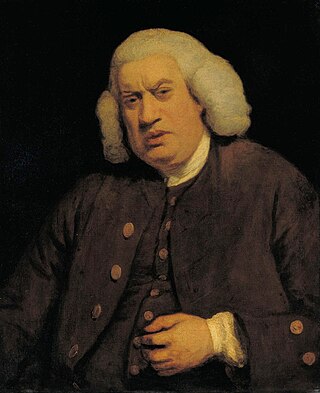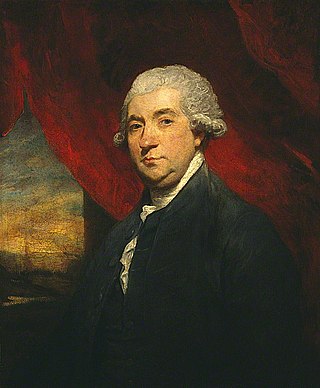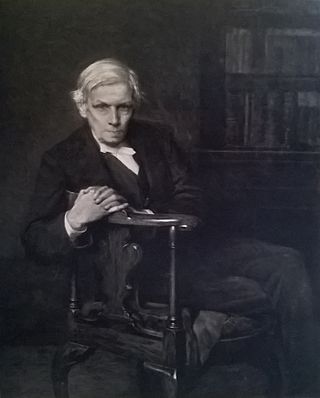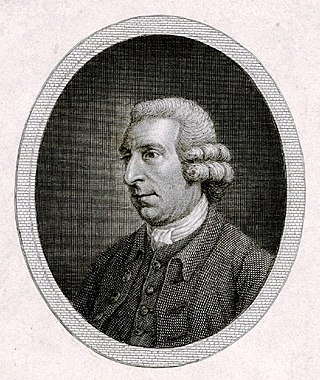
The Village is a narrative poem by George Crabbe, published in 1783. The poem contrasts the traditional representation of the rural idyll in Augustan poetry with the realities of village life.

The Village is a narrative poem by George Crabbe, published in 1783. The poem contrasts the traditional representation of the rural idyll in Augustan poetry with the realities of village life.
In early 1781 Crabbe wrote a letter to statesman and author Edmund Burke asking for help, in which he included samples of his poetry. Among the samples that Crabbe sent to Burke were pieces of his poems The Library and The Village which Burke viewed favourably, giving Crabbe a gift of money to relieve his immediate wants, and assuring him that he would do all in his power to further Crabbe's literary career. [1] The Village was published in May 1783. [2]
Samuel Johnson said of the poem in a letter to Reynolds, "I have sent you back Mr. Crabbe's poem, which I read with great delight. It is original, vigorous, and elegant." [3] Johnson's friend and biographer James Boswell also praised The Village. It was said at the time of publication that Johnson had made extensive changes to the poem, but Boswell responded by saying that "the aid given by Johnson to the poem, as to The Traveller and Deserted Village of Goldsmith, were so small as by no means to impair the distinguished merit of the author." [4]

Samuel Johnson, often called Dr Johnson, was an English writer who made lasting contributions as a poet, playwright, essayist, moralist, critic, biographer, editor, and lexicographer. The Oxford Dictionary of National Biography calls him "arguably the most distinguished man of letters in English history".

James Boswell, 9th Laird of Auchinleck, was a Scottish biographer, diarist, and lawyer, born in Edinburgh. He is best known for his biography of his friend and older contemporary, the English writer Samuel Johnson, which is commonly said to be the greatest biography written in the English language. A great mass of Boswell's diaries, letters, and private papers were recovered from the 1920s to the 1950s, and their ongoing publication by Yale University has transformed his reputation.

William Ernest Henley was an English poet, writer, critic and editor. Though he wrote several books of poetry, Henley is remembered most often for his 1875 poem "Invictus". A fixture in London literary circles, the one-legged Henley might have been the inspiration for Robert Louis Stevenson's character Long John Silver, while his young daughter Margaret Henley inspired J. M. Barrie's choice of the name Wendy for the heroine of his play Peter Pan (1904).
This article contains information about the literary events and publications of 1781.

George Crabbe was an English poet, surgeon and clergyman. He is best known for his early use of the realistic narrative form and his descriptions of middle and working-class life and people.

Anna Seward was an English Romantic poet, often called the Swan of Lichfield. She benefited from her father's progressive views on female education.

Edmond Malone was an Irish Shakespearean scholar and editor of the works of William Shakespeare.

The Deserted Village is a poem by Oliver Goldsmith published in 1770. It is a work of social commentary, and condemns rural depopulation and the pursuit of excessive wealth.

Alfred Ainger was an English biographer and critic.

Lives of the Most Eminent English Poets (1779–81), alternatively known by the shorter title Lives of the Poets, is a work by Samuel Johnson comprising short biographies and critical appraisals of 52 poets, most of whom lived during the eighteenth century. These were arranged, approximately, by date of death.

Thomas Percy was Bishop of Dromore, County Down, Ireland. Before being made bishop, he was chaplain to George III of the United Kingdom. Percy's greatest contribution is considered to be his Reliques of Ancient English Poetry (1765), the first of the great ballad collections, which was the one work most responsible for the ballad revival in English poetry that was a significant part of the Romantic movement.

John Scott, known as Scott of Amwell, was an English landscape gardener and writer on social matters. He was also the first notable Quaker poet, although in modern times he is remembered for only one anti-militarist poem.

The Club or Literary Club is a London dining club founded in February 1764 by the artist Joshua Reynolds and essayist Samuel Johnson, with Edmund Burke, the Anglo-Irish philosopher-politician.
Nationality words link to articles with information on the nation's poetry or literature.

Charles O'Conor,, also known as Charles O'Conor of Belanagare, was a member of the Gaelic nobility of Ireland and antiquarian who was enormously influential as a protagonist for the preservation of Irish culture and Irish mythology during the 18th-century. He combined an encyclopaedic knowledge of Irish manuscripts and Gaelic culture in demolishing many specious theories and suppositions concerning Irish history.

The Vanity of Human Wishes: The Tenth Satire of Juvenal Imitated is a poem by the English author Samuel Johnson. It was written in late 1748 and published in 1749. It was begun and completed while Johnson was busy writing A Dictionary of the English Language and it was the first published work to include Johnson's name on the title page.
Mary Leadbeater was an Irish author and diarist.

Samuel Johnson was an English author born in Lichfield, Staffordshire. He was a sickly infant who early on began to exhibit the tics that would influence how people viewed him in his later years. From childhood he displayed great intelligence and an eagerness for learning, but his early years were dominated by his family's financial strain and his efforts to establish himself as a school teacher.

An Account of Corsica is the earliest piece of writing related to the Grand Tour literature that was written by the Scottish author James Boswell. Its first and second editions were published in 1768, with a third edition within twelve months. The full title given to the journal is An account of Corsica, the journal of a tour to that island and memoirs of Pascal Paoli.

Robert Burns's Commonplace Book 1783–1785 is the first of three commonplace books that were produced by the poet. The contents cover drafts of songs and poems, observations, ideas, epitaphs, etc.